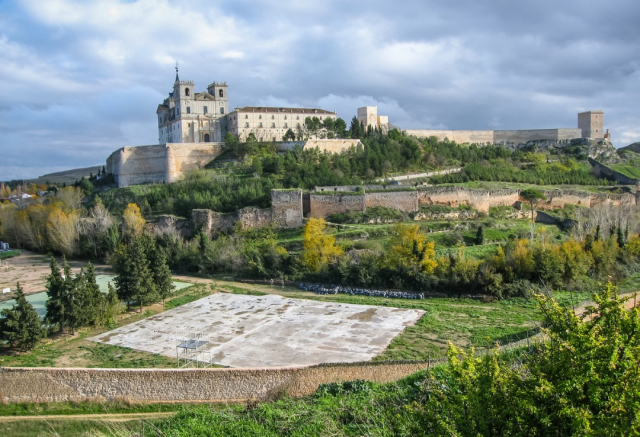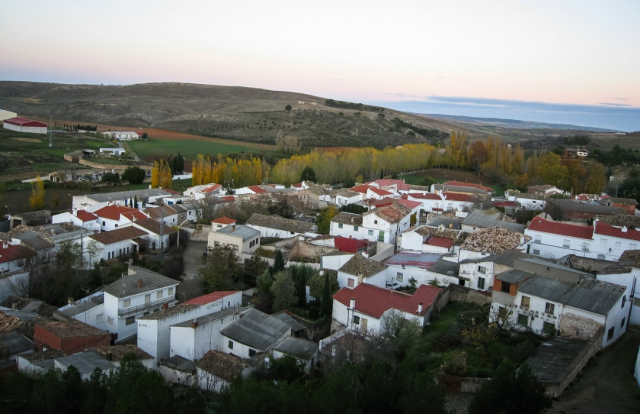Camino de Uclés: history, stages and relationship with the Camino de Santiago
The pilgrimage to Uclés leads to the second most important temple dedicated to the Apostle Santiago.
The Camino de Uclés starts from the city of Madrid, however it is not part of the Jacobean routes, since its destination is not the city of Santiago de Compostela, but the Monastery of Uclés.
Despite not leading pilgrims to the most important temple dedicated to the Apostle Santiago, he directs walkers to the second most relevant temple for this saint. We are talking about the Monastery of Uclés, the second best-known building dedicated to the Apostle Santiago, behind the Cathedral of Santiago.
The history of the Camino de Uclés
The Monastery of Uclés is also called the Monastery of Santiago, in honor of the apostle. It is located in the town of Uclés, in the province of Cuenca. Thanks to Manuel Rossi, the recuperator of this route, today we can enjoy this wonderful path.
Created in the 10th century by the Order of Santiago, it adopted the mission from the 12th century to protect pilgrims on the Camino de Santiago, and fight against Muslims. Thanks to this fortress, the Christians managed to defend themselves until the end of the 15th century Reconquest. Once the conflicts between Christians and Muslims ended, the castle lost its military function and became a monastic construction.
Two centuries after the works to convert the castle into a monastic construction were completed, the Santiago Knights settled. However, difficult times awaited the Monastery of Uclés, since in the 19th century it was damaged by the Napoleonic empire in the famous Battle of Uclés. At the end of the century, the order of Santiago was forced to leave the temple due to the confiscation of Mendizábal. In 1936, with the arrival of the Spanish Civil War and the temple on the Republican side, it was transformed into a hospital. At the end of the war, the deteriorated facilities were used as a prison.
Later, the Diocese of Cuenca claimed the monastery to use it as a place to train people with a priestly vocation. Since then, it is also known as "El Escorial de La Mancha", and has become a relevant point of interest in the province.
Stages the Camino de Uclés
It is not a difficult route to complete, most of the days are about 10 kilometers long. Almost the entire route is pedestrian and greenway, which makes it possible to do the Camino by bicycle and is also accessible for people in wheelchairs.
Despite the fact that the journey is divided into 11 stages by the location of the towns to be able to seal the credential, it could be perfectly completed in 6.
-
Madrid - Rivas VaciaMadrid (28.6 kilometers)
-
Rivas VaciaMadrid - La Poveda (4.3 kilometers)
-
La Poveda - Arganda del Rey (3.6 kilometers)
-
Arganda del Rey - Morata de Tajuña (17.8 kilometers)
-
Morata de Tajuña - Perales de Tajuña (7.1 kilometers)
-
Perales de Tajuña - Tielmes (8.3 kilometers)
-
Tielmes - Carabaña (9.2 kilometers)
-
Carabaña - Estremera (15.9 kilometers)
-
Estremera - Barajas de Melo (26.2 kilometers)
-
Barajas de Melo - Huelves (13.9 km)
-
Huelves - Uclés Monastery (9 kilometers)
Relationship with the Camino de Santiago
In April 2011, the Camino de Uclés was inaugurated again, after being forgotten for centuries. Manuel Rossi, the man who revived this route again, was dedicated to finding and revitalizing the old roads.
In 2010, a priest from Cuenca told him about the Camino de Uclés and he did not think about it and began his journey. However, after having reactivated the Camino de Uclés, his work did not end there as he began to signal the Camino de Uclés.
Its signs are characterized by having red arrows and the cross of Santiago, which can be seen throughout the journey. In addition, he also created the credential used for this Camino, the so-called "Uclessiana".
Currently the layout of the Camino de Uclés is as similar as possible to the original. With a route of almost 145 kilometers and divided into 11 stages, in which the official Uclessiana credential can be stamped by each town.
As for the signs, the Camino presents good indications thanks to Manuel Rossi. To make the Camino from Madrid to the Monastery of Uclés, pilgrims will find the signs for Manuel Rossi, while if they do it in reverse, the classic ones of the Camino de Santiago, yellow arrows and scallops will appear.
Routes
Blog
 ¿Vas a hacer el camino de Santiago? Cuida tus pies antes y después
¿Vas a hacer el camino de Santiago? Cuida tus pies antes y después
 5 razones por las que contratar un seguro de viajes
5 razones por las que contratar un seguro de viajes
 Formas de hacer un logotipo
Formas de hacer un logotipo
 La importancia del registro de llamadas durante tu viaje por el Camino de Santiago
La importancia del registro de llamadas durante tu viaje por el Camino de Santiago
Information
Points of interest
Cities & Towns | Hostels | Lodgings | Restaurants | Saddlery | Doctors | Points of interest | Bikes workshop
Contact us | Privacy policy | Cookies policy | | Terms of use | Authorship | Web Map | Consentimiento
© Copyright LA VOZ DE GALICIA S.A. Polígono de Sabón, Arteixo, A CORUÑA (ESPAÑA) Inscrita en el Registro Mercantil de A Coruña en el Tomo 2438 del Archivo, Sección General, a los folios 91 y siguientes, hoja C-2141. CIF: A-15000649

